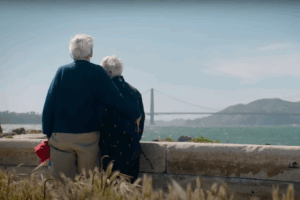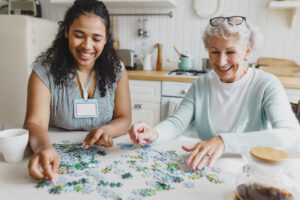Siobhan never considered herself an artist; in fact, if anyone had asked, she would have laughed at them. It’s not that she didn’t like art. She took a few art history classes in college, and, like many other people, had dreams about sitting on the Seine and painting. But life, as it does, happened for her, and as she worked and raised a family her art inclinations were limited to trips to the museum or shows on PBS. She certainly never tried to create anything.
Shortly after they both retired, her husband died of a heart attack. While she loved her children and grandchildren, Siobhan began to feel disconnected, without as much to fill her days. She missed her husband, missed working, and wasn’t sure how to articulate it. When she saw a flyer for art therapy, one of her friends convinced her to take a chance with it. She realized that this was more than just creation: it was true expression, and a way to understand herself better. Siobhan had begun down a path that has been fruitful and beneficial for many aging men and women. That path, art therapy, brought out the inner artist in Siobhan—and, more importantly, helped reveal the inner Siobhan.
What is art therapy?
Art therapy is a large umbrella that incorporates many types of artistic expression and creation[1. “What is art therapy?” 2013, https://www.arttherapy.org/upload/whatisarttherapy.pdf], including the use of drawing, painting, sculpting, needlework, crafting, music, dance, and more. However, even if we focus just on things older adults can make with their hands, a plethora of options emerges.
Needlework. From cross-stitching to knitting and all points in between, the rhythmic and relaxing art of needlework provides a sense of serenity and accomplishment. If your loved one lacks the manual dexterity for fine needlework, craft stores are filled with less precise projects that use felt, buttons, or larger needles.
Painting. You don’t have to be van Gogh to appreciate applying paint to canvas. Painting can continue as we age, as large brushes and brightly colored paints are great for older adults with arthritis or low vision. And don’t discount the use of finger paints, which are just as much fun for older generations as they are for younger ones!
Drawing. This is probably one of the simplest forms of art therapy; all you need is paper and pencil (colored or not), crayons, or similar implements. Your loved one can draw their own illustrations freehand, though many enjoy connecting the dots on pre-made ones (and then coloring them)!
Making collages. Making a collage with paper and glue can be an artistic outlet that doesn’t require as much manual dexterity as others. This form of art therapy is practically free if you supply the older adult with recycled newspapers, magazines, posters, and the like. And scissors aren’t even necessary—artfully ripped images are just as effective as cut ones, if not more.
The benefits of art therapy
Art, no matter the skill level of the artist, always produces content of value. The product can be of extreme importance to your aging loved one, but they gain benefits far beyond what they have created.
Stress relief. Anyone who engages regularly in art therapy can testify to its calming, soothing, effects. Recently, there’s been a growing trend in adult coloring books[2. “Hottest trend in publishing is adult coloring books,” December 13, 2015, https://nypost.com/2015/12/13/hottest-trend-in-publishing-is-adult-coloring-books/]—people of all ages are enjoying the release of this mindless and soothing task. Zoning out while focusing your brain on something besides stress is the perfect way to make it disappear.
Self-expression. If the older adult in your life is coping with grief, loss, chronic illness, or other ongoing types of pain, it’s easy to feel like their personality gets lost. Their identity can become wrapped up in that of a widow, widower, patient, or other labels with negative associations. Art therapy reminds them that they are a singular individual with a great deal to offer the world, and lets their personality shine through in their designs.
Help coping with trauma. Art therapy is frequently used to help people process trauma, and older adults are no different. It can be helpful for them to “paint” or “draw” their feelings about loss of a loved one, a serious medical condition, or troubling feelings or situations, like friends moving away.
Having a purpose. Once they’ve raised their families and retired from working life, many older adults miss the sense of purpose they once had. Art therapy is a useful tool to fill that void. Many individuals report a feeling of deep meaning in making something, sharing it, and displaying their creations.
Start art therapy for seniors at home
Art therapy for seniors can make just as much difference in their lives as other types of therapy, just in a different way. And a wonderful part of it is, you don’t need to take them to a special location in order to access it. While trained art therapists can guide people through the process, there is still benefit to be found in creation, even if you’re just working on things at home by yourself. All it takes is a few supplies, a little ingenuity, and a willing participant, to get stated on a journey towards increased mental well-being. Feel free to accompany your loved one on their therapeutic journey by doing art along with them. Who knows—before long, you will even begin to feel the benefits of this unique medicine yourself!
If you are unsure of how to best help an aging loved one, the trained and compassionate staff at the Institute on Aging is here to help you make that decision and gain the best in at-home care for older adults. Contact us to find out more.







